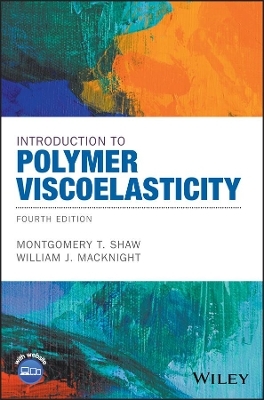
Introduction to Polymer Viscoelasticity
John Wiley & Sons (Verlag)
978-1-119-18180-4 (ISBN)
Original 1972 edition by John J. Aklonis, William J. MacKnight, and Mitchel Shen
Completely revised and updated, the fourth edition of this classic text continues to offer the reader a thorough understanding of viscoelastic behavior, essential for the proper utilization of polymers.
- Explains principles, corresponding equations, and experimental methods with supporting real-life applications
- Adds coverage of measurement techniques (nano-indentation, atomic force microscopy (AFM), and diffusing wave spectroscopy (DWS)), biopolymer viscoelasticity, and the relationship between mechanical polymer properties and viscoelastic functions
- Has two new ections to address modern areas of viscoelastic measurement: large amplitude oscillatory shear (LAOS) and microrheology
- Includes problems in the text and an Instructor's Manual (including solutions) available for adopting professors
- Erläutert die Prinzipien, zugehörigen Gleichungen und experimentelle Methoden, die durch praktische Anwendungen ergänzt werden. Begleitende Website mit weiteren hilfreichen Daten.
- Behandelt Messverfahren (Nanoindentation, Rasterkraftmikroskopie (AFM), Vielfachstreuung von Licht (Diffusing Wave Spectroscopy DWS)), die Viskoelastizität von Biopolymeren und den Zusammenhang zwischen den mechanischen Eigenschaften von Polymeren und viskoelastischen Funktionen.
- Beinhaltet zwei neue Abschnitte über moderne Bereiche von viskoelastischen Messungen: oszillatorische Scherung (Large Amplitude Oscillatory Shear LAOS) und Mikrorheologie.
- Problemstellungen im Text. Ein Handbuch für Dozenten (mit Lösungen) ist verfügbar.
- Überaus positive Rezensionen zur 3. Auflage (CHOICE, Dezember 2005, und Polymer News Dezember 2005).
- Begleitende Website.
MONTGOMERY T. SHAW, PhD, is Emeritus Distinguished Professor of Chemical Engineering at the University of Connecticut. Among his books are the prior edition of Introduction to Polymer Viscoelasticity and Introduction to Polymer Rheology, both published by Wiley.
WILLIAM J. MACKNIGHT, PhD, is a Professor Emeritus at the University of Massachusetts Amherst, where he was formerly the co-Principal Investigator for the Center for UMass/Industry Research on Polymers (CUMIRP). He has been a co-author for each edition of Introduction to Polymer Viscoelasticity, all published by Wiley.
Preface to the Fourth Edition
Preface to the Third Edition
Preface to the Second Edition
Preface to the First Edition
1. Introduction
PROBLEMS, 6
GENERAL REFERENCE TEXTS, 7
REFERENCES, 8
2. Phenomenological Treatment of Viscoelasticity
A. ELASTIC MODULUS, 9
B. TRANSIENT EXPERIMENTS, 21
C. DYNAMIC EXPERIMENTS, 25
1. Low-Strain Measurements, 25
2. Large Amplitude Oscillatory Shear (LAOS), 30
3. Microrheology, 34
D. BOLTZMANN SUPERPOSITION PRINCIPLE, 38
E. RELATIONSHIP BETWEEN THE CREEP COMPLIANCE AND THE STRESS RELAXATION MODULUS, 43
F. RELATIONSHIP BETWEEN STATIC AND DYNAMIC PROPERTIES, 44
APPENDIX 2-1. Connecting Creep Compliance and Stress Relaxation Modulus Using Laplace Transforms, 45
APPENDIX 2-2. Borel s Theorem, 48
APPENDIX 2-3. Geometries for the Measurement of Viscoelastic Functions, 49
1. Linear Motion Geometries, 49
2. Rotational Motion Geometries, 53
PROBLEMS, 57
REFERENCES, 64
3. Viscoelastic Models
A. MECHANICAL ELEMENTS, 66
1. Maxwell Model, 68
2. Voigt Model, 74
3. Generalized Maxwell Model, 76
4. Voigt-Kelvin model, 79
B. DISTRIBUTIONS OF RELAXATION AND RETARDATION TIMES, 81
C. MOLECULAR THEORIES THE ROUSE MODEL, 84
D. APPLICATION OF FLEXIBLE-CHAIN MODELS TO SOLUTIONS, 93
E. THE ZIMM MODIFICATION, 94
F. EXTENSION TO BULK POLYMER, 96
G. REPTATION, 108
APPENDIX 3-1: MANIPULATION OF THE ROUSE MATRIX, 112
PROBLEMS, 117
REFERENCES, 123
4. Time Temperature Correspondence
A. FOUR REGIONS OF VISCOELASTIC BEHAVIOR, 125
B. TIME TEMPERATURE SUPERPOSITION, 133
C. MASTER CURVES, 136
D. THE WLF EQUATION, 136
E. MOLECULAR INTERPRETATION OF VISCOELASTIC RESPONSE, 143
PROBLEMS, 144
REFERENCES, 149
5. Transitions and Relaxation in Amorphous Polymers
A. PHENOMENOLOGY OF THE GLASS TRANSITION, 150
B. THEORIES OF THE GLASS TRANSITION, 155
1. Free-Volume Theory, 155
2. Thermodynamic Theory, 158
3. Kinetic Theories, 164
C. STRUCTURAL PARAMETERS AFFECTING THE GLASS TRANSITION, 166
D. RELAXATIONS IN THE GLASSY STATE, 172
E. RELAXATION PROCESSES IN NETWORKS, 176
1. Physical Relaxation, 176
2. Chemical Processes, 177
F. BIOPOLYMER VISCOELASTICITY, 180
1. Biopolymer Sources, 180
2. Humidity Control, 181
3. Examples of Biopolymer Viscoelastic Response, 183
PROBLEMS, 189
REFERENCES, 196
6. Elasticity of Rubbery Networks
A. THERMODYNAMIC TREATMENT, 199
B. STATISTICAL TREATMENT, 205
1. Derivation, 205
2. Energy Contribution, 216
C. PHENOMENOLOGICAL TREATMENT, 220
D. FACTORS AFFECTING RUBBER ELASTICITY, 224
1. Effect of Degree of Crosslinking, 224
2. Effect of Swelling, 226
3. Effect of Fillers, 229
4. Effect of Strain-Induced Crystallization, 232
APPENDIX 6-1. Statistics of a Polymer Chain, 234
APPENDIX 6-2. Equation of State for a Polymer Chain, 240
PROBLEMS, 242
REFERENCES, 246
7. Dielectric and NMR Methods
A. DIELECTRIC METHODS, 249
1. Phenomenology, 250
2. Molecular Interpretation of Dielectric Constant, 257
3. Interfacial Polarization, 264
4. Application to Polymers, 265
5. Experimental Methods, 268
6. Application of Dielectric Relaxation to Poly (methyl methacrylate), 272
7. Comparisons between Mechanical and Dielectric Relaxation for Polymers, 273
B. NUCLEAR MAGNETIC RESONANCE METHODS, 274
PROBLEMS, 280
REFERENCES, 282
Answers to Selected Problems
CHAPTER 2, 284
CHAPTER 3, 296
CHAPTER 4, 304
CHAPTER 5, 308
CHAPTER 6, 312
CHAPTER 7, 320
List of Major Symbols
List of Files on Website
Author Index
Subject Index
Prior edition reviews: The book is clear written and...[is] appropriate for students in introductory undergraduate courses and for others wanting introduction to the fundamentals of the subject.
(CHOICE, December 2005); This book is invariably well written, logically organized and easy to follow...I highly recommend this book to anyone studying polymer viscoelasticity.
(Polymer News, December 2005)
| Erscheinungsdatum | 02.08.2018 |
|---|---|
| Verlagsort | New York |
| Sprache | englisch |
| Maße | 176 x 257 mm |
| Gewicht | 992 g |
| Einbandart | gebunden |
| Themenwelt | Naturwissenschaften ► Chemie ► Physikalische Chemie |
| Naturwissenschaften ► Physik / Astronomie | |
| Technik ► Maschinenbau | |
| Technik ► Umwelttechnik / Biotechnologie | |
| ISBN-10 | 1-119-18180-1 / 1119181801 |
| ISBN-13 | 978-1-119-18180-4 / 9781119181804 |
| Zustand | Neuware |
| Informationen gemäß Produktsicherheitsverordnung (GPSR) | |
| Haben Sie eine Frage zum Produkt? |
aus dem Bereich


